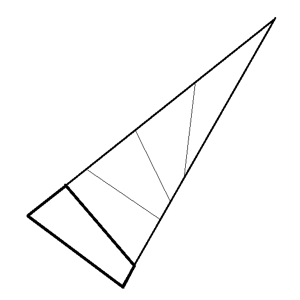I can sketch a proof based on assuming this "finite" result:
A). For any pentagonal star one of the 5 triangles will have area strictly
smaller than that of the central pentagon.
(I think a brute force attack should yield a proof here.)

The proof of the original problem would then go as follows.
b). A) generalizes to n-agons by considering the pentagon
spanned by any 5 vertices.

c). b) implies that a tiling with polygons of EQUAL AREA
is not possible unless all polygons are either triangles or
quadrilaterals.
d). Take one 4-tile and continue tiling next to it inside
the cone enclosed by the converging lines of 2 opposite edges;
we have a sequence of quadrilaterals which must end with a
triangle were the the 2 lines meet. This shows that the tiling
must contain a 3-tile somewhere.

e). By d) take a 3-tile and continue tiling outwards, inside each of the
3 beams generated by the lines of each pair of edges; the original 3-tile
will be the first tile in each beam, but every other tile after it must be
a 4-tile (build them one at a time and keep using c)).
We can ignore what happens in the 3 leftover cones radiating from the 3 vertices.

f). In one of the 3 beams (which now look like ladders) take any one of the new rungs
from step e) and extend it - that line will then collide with one of the other
2 beams (but cannot overlap with any of its rungs). That will cut
one of the 4-tiles, creating a 5-tile.

Apologies for bumping up the question repeatedly while trying to edit my answer.





